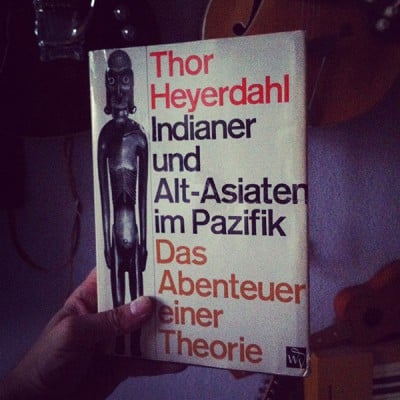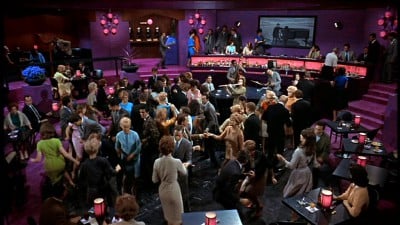link to vimeo
posted by: Berlin Surfguitar
post categories: Moving Pictures
link to vimeo
I just watched this. It’s really interesting. Trust me.
I can’t get enough of this stuff. Reading every book by Thor Heyerdahl I could find, gave me an idea of his theories concerning the ethnologic history of the Pacific. What I didn’t know was that more and more interested people keep coming up with theories and evidence strengthening the hypothesis. With today’s genetic proof the plot thickens quite a bit. This is my real nerdy side I guess. Too bad Heyerdahl passed in 2002, oh well …
Polynesian Pathways
Genetics Rewrites Pacific Prehistory
Some Background on the Harappa People
Easter Island – Indus Valley Script
Early Americans helped colonise Easter Island
However, Thorsby’s findings don’t mean that Heyerdahl’s ideas have been vindicated. The first settlers to Polynesia came from Asia, and they made the biggest contribution to the population. ‘Heyerdahl was wrong,’ Thorsby says, ‘but not completely.’
What??! I don’t recall reading one single line by Heyerdahl that suggested exclusive colonization of Polynesia from South-America. Contrary – during Thor Heyerdahl’s lifetime – it was the established scholars who claimed exclusive exploration of the pacific islands eastward, from Southeast Asia. Despite the abundance of confirming findings – in biology, anthropology, nautical science and archeology – that he presented. In Indians and Old Asians in the Pacific he explained the Japan Current and the likely connection between East Asia and the American Northwest. Further, the ethnographic connections of the Northwest, Hawai’i and New Zealand Heyerdahl drew, have now been confirmed by fellow scientists, as displayed following the links above.
Speaking of Asia as a place of origin, the Southeast Asia theory of old, viewing the Lapita Culture as the ancestors of the Polynesians, has been replaced with Taiwan (through Heyerdahl’s Japan Current) – even by today’s academics. Putting Lapita on the western border and Taiwanese descendents at the center of Polynesia.

Not only have natural catastrophes changed the course of history, but there is much that has been lost to conquering tribes. This is not to say the defeated did not contribute to the resultant culture. Their language and history may have been lost, but genetic and cultural elements of that pre-existing culture remain. The victorious tribe does not make an effort to tell the history of the vanquished, but they glean what they can use and trash the rest. Therefore when attempting to use language to trace the history of man, we must remember it will only tell us half the story.
The Polynesians are the product of many encounters, with tribes of differing backgrounds, that is why their early history has so many conflicting stories. It is also why they are culturally rich. They did not come from one place, but they came from many places. They as a culture were created in the Pacific.
The Polynesians are a combination of fragments of civilizations from both east and west, with a history going back a very long way. The Hawaiian genealogy goes back to Lai Lai who existed 16,000 years ago, but unfortunately such stories have, sadly, been passed off as mere folklore.
Due to their isolation, people on the scattered isles of the Pacific have retained cultural traits from their ancestral civilizations. Isolated island communities are in some ways veritable time capsules of past civilizations, with certain belief systems dating back over 12,000 years. By comparing cultural traits throughout the region and identifying what they have in common, we can start to build up a picture of what these ancient civilizations were once like. To ignore these connections is to ignore a veritable treasure trove of information. I have merely scratched the surface in this article and much work is yet to be done. Unfortunately 140m of water, tens of metres of sediments and the passage of time make it very hard to piece together this most interesting period of human prehistory.
Quote from Conclusion by Peter Marsh
where to see the film: Don’t Think I’ve Forgotten: Cambodia’s Lost Rock & Roll
In this video Jonathan Taplin talks about the tech revolution, today’s big players connection to libertarianism and what it all means for us.
A professional diver took inventory of 200km of Canada’s west coast.
(video has since been removed)
Update
The assumption, made in the video, that this dramatic development was caused by the nuclear desaster in Fukushima is not scientifically founded, or so says Motherload – The Pacific Ocean Isn’t Dying Because of Fukushima

Yesterday I had the idea to create a twitter account posting links that document life (mostly images) under Keynesian Economics.
I had realized it’s not so much the artist, designer or architect that decides the style of an era, but the conditions, the societies that these creatives are working in.
Some person may be a natural born architect. But what the buildings actually look like is much more dictated by the times than by the individual. The same guy working under Louis XIV would build different things than, say, in the mid-century-modern era – which I call the Keynes-Era.
Style is of course just one aspect of life. But it’s the first thing you realize that is changing between eras. And we see much more than skirt lengths in fashion photos. We see if women wore veils or burkas in the mid-east in 1958.
Photos transport moods, especially in everyday, real life scenes – by professional photographers as well as hobbyists. And the attention which hobbies themselves do get in the media, does also say something about a culture.
A picture says more than a thousand words. Many of these words are about the life, the people, the conditions, few about the creators. The director who understands that, like Jean-Luc Godard, has a greater chance to shape an era than the one with a more individualistic theme, say, Woody Allen.
link to vimeo